

Dr1506 + Follow
Download PresentationAn Image/Link below is provided (as is) to download presentation Download Policy: Content on the Website is provided to you AS IS for your information and personal use and may not be sold / licensed / shared on other websites without getting consent from its author. Content is provided to you AS IS for your information and personal use only. Download presentation by click this link. While downloading, if for some reason you are not able to download a presentation, the publisher may have deleted the file from their server. During download, if you can't get a presentation, the file might be deleted by the publisher.

Basal Cell Carcinoma. What is it?.
774 views • 9 slides
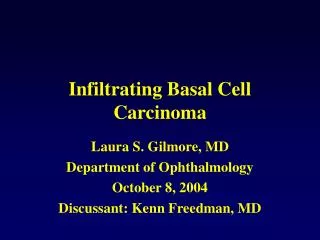
Infiltrating Basal Cell Carcinoma. Laura S. Gilmore, MD Department of Ophthalmology October 8, 2004 Discussant: Kenn Freedman, MD. Case Presentation. CC: growth on right side of nose HPI: 81 yo HF who first noted growth on right side of nose “last December”, progressively growing.
852 views • 22 slides
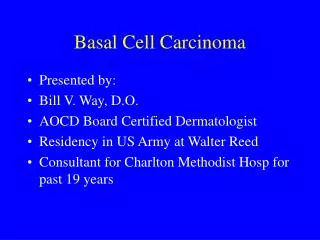
Basal Cell Carcinoma. Presented by: Bill V. Way, D.O. AOCD Board Certified Dermatologist Residency in US Army at Walter Reed Consultant for Charlton Methodist Hosp for past 19 years. Epidemiology and Etiology. Incidence US 500-1000 per 100,000 >400,000 new patients annually
927 views • 61 slides

RENAL CELL CARCINOMA. GENETIC BASIS. BACKGROUND. 3% of adult malignancies 90-95% of neoplasms arising from the kidney [tissue of origin - proximal renal tubular epithelium ] Lack of early warning signs, diverse clinical manifestations
578 views • 20 slides

Case presentation. 57 yo male was Dx with a 5x6 cm RCC in 7/99 by CT. Bone scan negative. Underwent radical nephrectomy in 9/99. Margins were free with no invasion into capsule or renal pelvis. Retroperitoneal fat specimen was unremarkable.2/01 bone scan negativeIn 12/02 develped ascites and
939 views • 53 slides

1.17k views • 19 slides
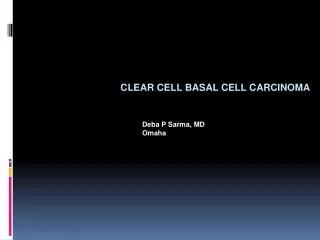
Deba P Sarma , MD Omaha. Clear cell basal cell carcinoma . A 65-year-old male presented with a 0.9 cm dome-shaped dark lesion on his upper chest. Figure 1: Low-power examination revealed a dermal basaloid tumor that comprised nests with clear cell changes present.
394 views • 18 slides

Locally Advanced and Metastatic Basal Cell Carcinoma: Medical Oncology Perspective. Karl D. Lewis, MD Associate Professor of Medicine University of Colorado Denver Cutaneous Oncology Program. Basal Cell Carcinoma. Arise from the keratinocytes of the basal layer of the epidermis
622 views • 32 slides
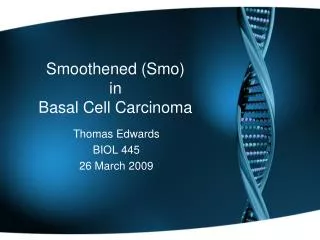
Smoothened (Smo) in Basal Cell Carcinoma. Thomas Edwards BIOL 445 26 March 2009. Hedgehog Signaling Pathway Review. Active during embryonic development. Highly conserved Integral to the formation of important body systems in vertebrates. Also active after development.
285 views • 10 slides
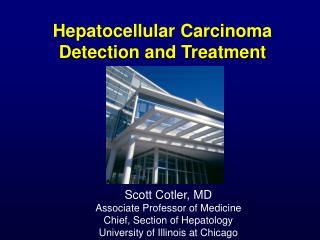
Hepatocellular Carcinoma Detection and Treatment. Scott Cotler, MD Associate Professor of Medicine Chief, Section of Hepatology University of Illinois at Chicago. Annual Report to the Nation on the Status of Cancer 1975-2002. Annual Percent Change. Liver Cancer in Men.
480 views • 21 slides

Infiltrating Basal Cell Carcinoma. Maysoon ALGain Dermatology Demonstrator KAAU. Case Presentation. CC: growth on right side of nose HPI: 81 yo HF who first noted growth on right side of nose “last December”, progressively growing. PMH: arthritis SH: ½ ppd smoker X 25 years
408 views • 22 slides
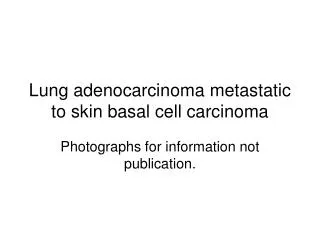
Lung adenocarcinoma metastatic to skin basal cell carcinoma. Photographs for information not publication. Lung core HE x100. LUNG CORE CK7 x 100. LUNG CORE TTF-1 x100. LUNG CORE DPAS X400. BCC. Adenoca. SKIN HE x 20. ADENOCA. BCC. SKIN CK7 x 40. ADENOCA. BCC. SKIN CK5/6 x 40.
259 views • 13 slides

Treatment Options for Renal Cell Carcinoma. By: Anthony Jurayj. Outline. Introduction Background Stages Studies Conclusion. What is Renal Cell Carcinoma.
510 views • 15 slides

Deba P Sarma , MD Omaha. Clear cell basal cell carcinoma. A 65-year-old male presented with a 0.9 cm dome-shaped dark lesion on his upper chest. Figure 1: Low-power examination revealed a dermal basaloid tumor that comprised nests with clear cell changes present.
349 views • 18 slides

Patched and Basal Cell Carcinoma. Matt Darch. Patched. Patched Description. Abbreviated Ptc Characterized as a tumor suppressor Sonic Hedgehog pathway 12 “pass” transmembrane receptor Binds to a ligand (Shh). Sonic Hedgehog Pathway. Actually named after the video game character.
347 views • 19 slides

RnRMarketResearch adds ‘Basal Cell Carcinoma (Basal Cell Epithelioma) Pipeline Review, H1 2015’ to its store. This report provides comprehensive information on the therapeutic development for Basal Cell Carcinoma (Basal Cell Epithelioma), complete with comparative analysis at various stages.
233 views • 6 slides

Basal Cell Carcinoma (Basal Cell Epithelioma) - Pipeline Review, H2 2015 market research report is the latest addition to RnRMarketResearch.com and its collection of therapeutics business intelligence reports aimed to help take better decisions
191 views • 6 slides
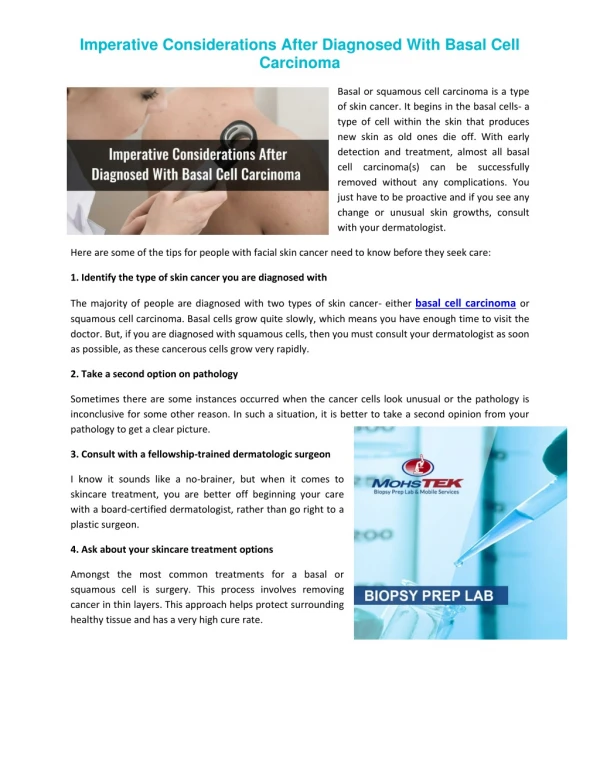
MOHS-TEK began its roots within the medical community over 25 years ago. Mohs Micrographic Surgery is primarily used to treat basal and squamous cell carcinomas, but can be used to treat less common tumors including melanoma. Mohs surgeons examine the removed tissue for evidence of extended cancer roots. Once the visible tumor is removed, Mohs surgeons trace the paths of the tumor using two key tools: A map of the surgical site, A microscope. To know more visit our site.

Basal cell carcinoma: Review Deba P Sarma, MD., Omaha. Basal cell carcinoma (BCC) Most common malignant tumor of the skin in man is basal cell carcinoma. BCC occurs mostly in the sun-exposed skin, such as head and neck and dorsum of hand, though it can occur in any part of he body.
275 views • 24 slides

Global Basal Cell Carcinoma Treatment Market is anticipated to reach a value of over USD xx billion by 2028 and register a CAGR of xx% for the forecast period 2022-2028.
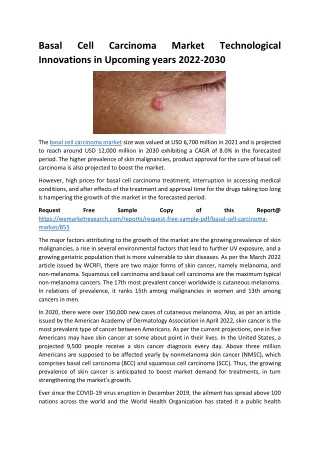
The global basal cell carcinoma market size was valued at USD 6,700 million in 2021 and is projected to reach around USD 12,000 million in 2030 exhibiting a CAGR of 8.0% in the forecasted period.

The basal cell carcinoma treatment market size has grown rapidly in recent years. It will grow from $6.69 billion in 2023 to $7.42 billion in 2024 at a compound annual growth rate (CAGR) of 10.8%.